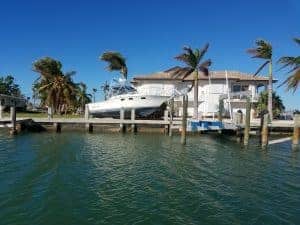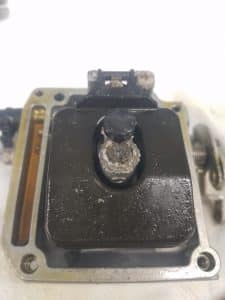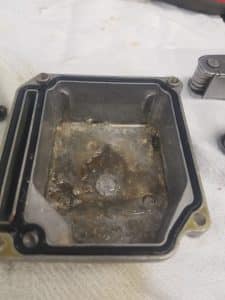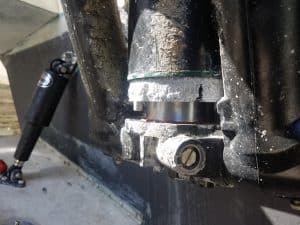While working in the Marine Industry at a very busy marina. So many times I hear a very common question.
Should I leave my engine up or down? Simply put, if you are leaving the boat in the water, leave it in the up position to avoid growth. If you are leaving it out of the water, trim it down to drain the water and protect the Power Tilt and Trim seals from the sun.
Though there are many other variables that will explain these two answers, there are a couple of questions that you should ask to determine the correct one for your own personal situation.
Where Do You Live?
Where you live plays a huge factor in this decision. If you keep your boat on a freshwater lake, in the Northern Hemisphere in cold saltwater, or down in the Caribbean Blue in hot saltwater? The effects will be different depending upon your location.
Something that is looked over a lot of times is the location and application. This will play a huge part in your decision.
If your boat is in the freshwater of a lake or the cold saltwater, does not have the same effect on the engine as it does in a location where the water temperature is much warmer.
Freshwater does not have the same minerals and capabilities for growth as saltwater does. As well as the difference in the cold vs. the hot saltwater.
Warm salt water gives the ability for growth and speeds up the process in which it occurs.
A boat left in the water in the Bahamas will grow barnacles faster than one left in the water in New York. The barnacles will grow on the bottom of the boat and also on the engine if it is left down in the water.
How Do You Use Your Boat?
With the understanding of the barnacle build-up. How you use your boat plays another big part.
Let’s say you get back from using your boat, be it fishing, diving, cruising, or however you like, and it is later in the evening or at night.
Then you are planning on using it again in the morning. It isn’t going to hurt anything leaving it in the water in the down position, or trimmed up.
This is all personal preference, but if you are going to let the boat sit for a week or two. Well, then in this case it is best to trim the engine up out of the water to avoid that growth issue we talked about earlier.
A Little on Flushing the Engine.
I’d like to also add to this by speaking on flushing the engine as well. The same concept will apply here for flushing the engine.
There are many people that flush their engines with freshwater religiously after every use. Don’t get me wrong here, there is nothing wrong with that.
What I’m saying is that if you are going to use the boat again in a few hours, (the next morning), then not flushing it isn’t going to hurt anything either.
Vice versa, if you are leaving or don’t plan on using the boat for a week or two. Then you definitely want to make sure you trim it up and flush it out.
To be clear here, we are talking about Outboard engines. Also, there is a misconception that people believe that you need to run the engine in order to flush it. That is not true.
If the engine has a flushing port, you can hook up the garden hose, turn it on, and with the engine tilted up, let it run for 5, 10, or 15 minutes, or as long as you’d like. (Be careful because eventually you forget and the water runs all night long!)
This will flush the engine out just fine. You can even run the engine like this if you’d like to. Just be careful not to be advancing the idle and revving the engine up to 3,000 RPM. That is, just to run it at idle!
Long Term Storage and Freezing Problems!
If you are planning to put the boat away and leave it in storage for an extended amount of time. You want to leave the engine in the totally trimmed down position.
This will allow all of the water to leak out of the engine, midsection, and lower unit. This will avoid freezing water and major problems!
It is also important that you either summerize it for the Southerners or winterize it for the Northerners.
This will include checking the gear lube in the gear case or lower unit. Make sure that there is not any water in the Lower Unit that could rust gears or freeze and destroy the gear case by flushing the engine with fresh water.
And fogging the engine with a good engine fogging oil to keep the cylinder walls, pistons, crank, and other engine parts freshly oiled.
Also, put a fuel stabilizer in the last fill-up before storage. You want to put the stabilizer in and use the boat a little to get the fuel and stabilizer mixed together properly and have all the fuel in the fuel lines treated.
Then you want to drain the Carburetors or Vapor Separator Tank on the engine. This will avoid gumming in the Carbs or sending poor stale fuel through the injectors on startup when your ready to use the boat again.
A Quick Tip on Ethanol Fuel.
This is a good time to give a quick tip on the fuel you use in your boat. The warmer the region you live in, the worse it is. Most boat fuel tanks have vents to the outside of the boat for ambient air.
Basically what happens is ethanol pulls in the condensation from the air over time, creating a collection of water in your fuel tank. That is the problem.
So, if you are going to store your boat with a full tank of fuel or even a half tank of fuel, try to put non-ethanol, REC-90 fuel, or even aviation fuel if you can get it.
This will prolong the quality of the fuel and get rid of the problem of having a fuel tank full of water when you go to use your boat.
Aviation fuel has a shelf life of about 2 years. If you are storing your boat for longer than that, plan on pumping out any fuel that is left in it before using it!
There is a way that you can safely use ethanol fuel in your boat though! And you can learn all about how you can do that in this article here!
Last Thoughts on Trimming and Electrolysis.
One last thing to think about when deciding to leave your engine up or down. What is the situation there where you are docking it?
If there are a lot of boat lifts in the water or a lot of lights in the water. Or even just a lot of power options on the docks…
You want to be conscious of stray currents in the water. A lot of stray electricity in the water will turn your boat, engine, and engine bracket into the ground location for it to go.
This will eat away at your lower units, trim tabs, thru-hulls, engine brackets, and anything else that is below the water line on your boat.
Obviously, you want to avoid a situation like this at all costs, but nevertheless, it is still something to think about when deciding whether or not to leave your engine up or down.
I hope this was helpful to you and that it gives you a little more insight and reasons upon deciding what position to leave your outboard engine.
Check Us Out!
We hope that this has been insightful and allowed you to understand the importance of what position you should leave your outboard in!
If you have more questions or want to learn more about your boat and its different systems. You should consider joining our Boating Academy where we have created HUNDREDS of video courses teaching you basically everything about your boat!
There are also even more helpful videos on our Youtube channel where we create even more boating videos!
You can also save some money by using our coupons when you need to buy stuff from your boat by using any of these coupons here at Partsvu!
And if you would like to support us to continue bringing you great content, please click the link below to Amazon where we get a commission from anything you are already going to buy! Click Here To Amazon!
Here are some other super helpful articles that you might find interesting!
Check out our YouTube Channel Here where we cover in depth in servicing outboard engines of many brands. Along with some adventures and other boating repairs, restorations, and tricks. Get subscribed and then connect with us by leaving a comment below or you can contact us directly by sending us an email using the form below, if you would like something more in depth! Have a great day and enjoy your boat!
[contact-form][contact-field label=”How Can We Reach You?” type=”email” required=”1″][contact-field label=”What Can we Do for Your?” type=”textarea” required=”1″][/contact-form]






